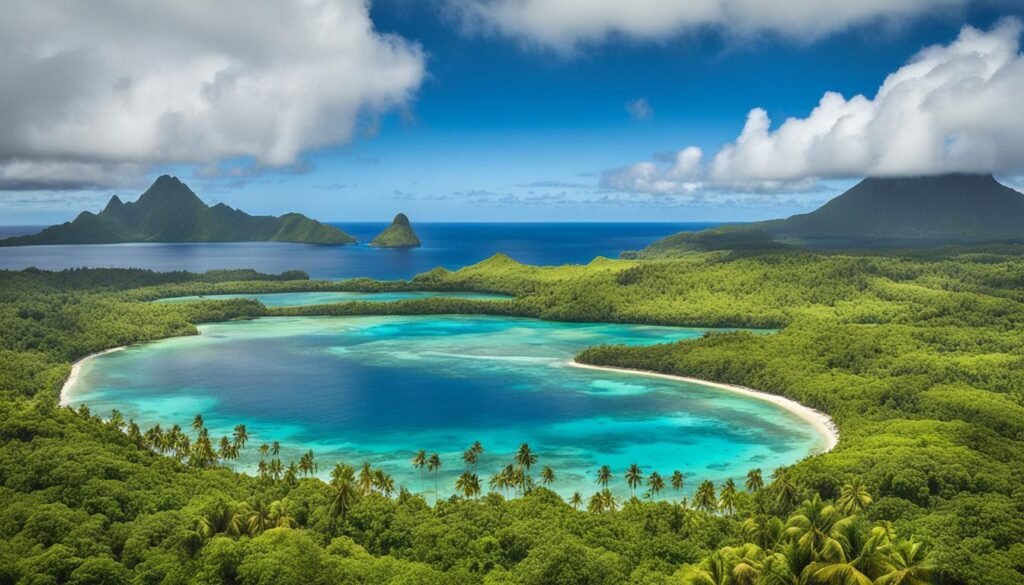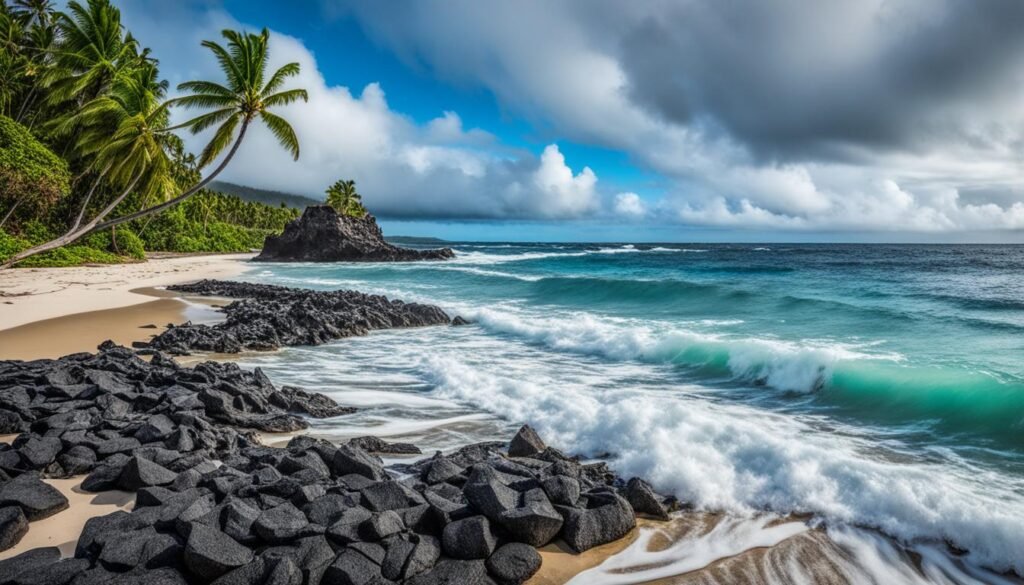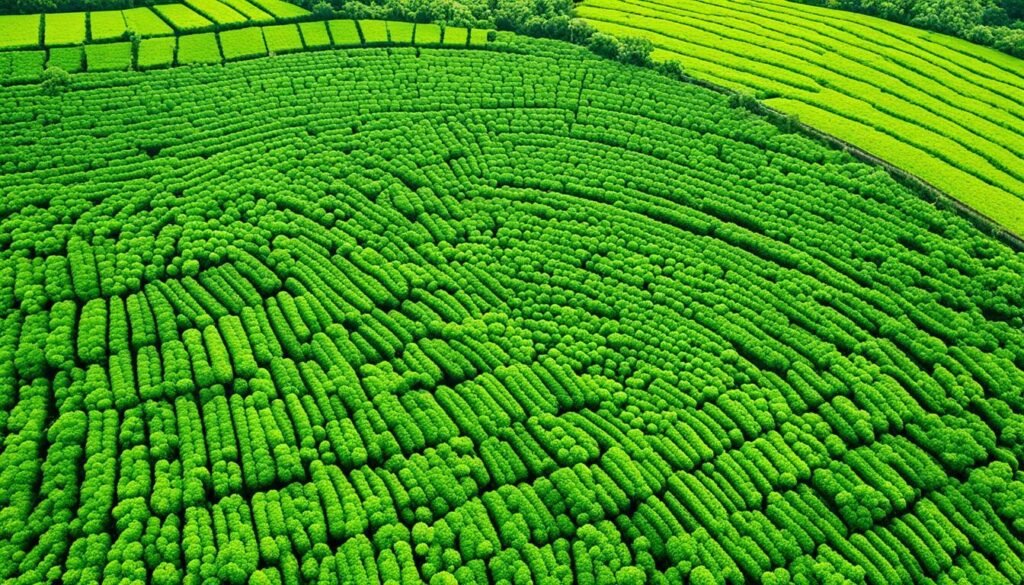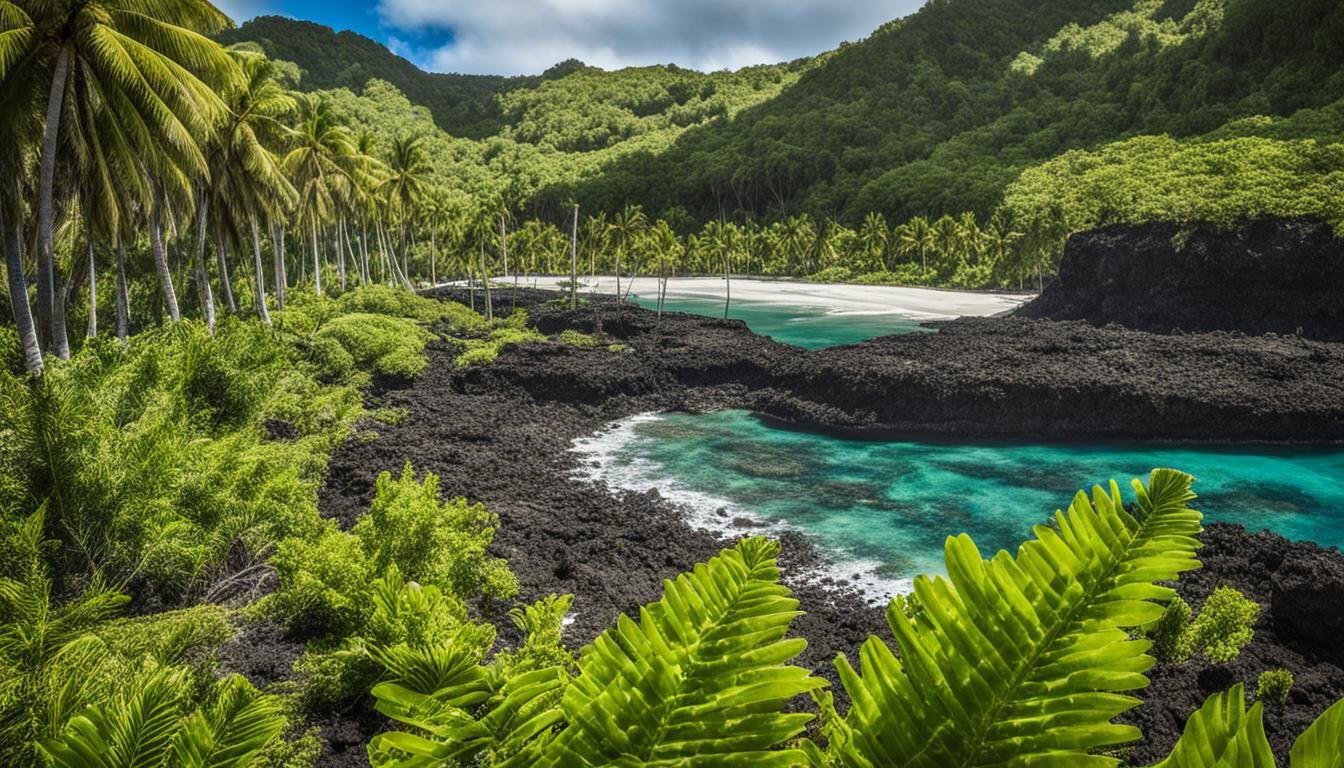Did you know that Samoa, a small island nation in the South Pacific, has been at the forefront of climate change adaptation and disaster risk reduction efforts? With a total area of just 2,931 square kilometers and a coastline stretching over 403 kilometers, this island country is facing the brunt of the climate crisis, but it is also leading the way in building resilience and sustainability.
Samoa is the first country in the Polynesian region to have gained independence in 1962, and its journey towards a climate-resilient future has been both challenging and inspiring. From the capital city of Apia, located on the island of Upolu, to the larger island of Savai’i and the surrounding smaller islands, Samoa is a testament to the power of community-driven climate action and international cooperation.
Key Takeaways
- Samoa is a small island nation in the South Pacific, facing the brunt of the climate crisis.
- The country has been at the forefront of climate change adaptation and disaster risk reduction efforts.
- Samoa is leading the way in building resilience and sustainability, with a focus on community-driven climate action.
- The capital city of Apia and the larger island of Savai’i are playing a crucial role in Samoa’s climate resilience efforts.
- International cooperation is a key factor in Samoa’s progress towards a climate-resilient future.
Geographic Overview of Samoa
The Polynesian island nation of Samoa is situated in the South Pacific Ocean, comprising two main islands, Savai’i and Upolu, along with several smaller surrounding islands. With a total area of approximately 2,931 square kilometers and a coastline stretching for 403 kilometers, Samoa’s geography is defined by its lush, tropical landscapes and volcanic terrain.
Location and Size
Samoa is located within the Polynesian region of the South Pacific, roughly halfway between Hawaii and New Zealand. The main islands of Savai’i and Upolu account for the majority of Samoa’s total land area, with the smaller islands of Manono, Apolima, and several uninhabited islets making up the rest of the country’s geography. As a Polynesian island nation, Samoa’s unique location and size shape its diverse ecosystems and cultural identity.

Climate Risks and Impacts
Samoa, a Pacific Island nation, faces significant challenges due to the impacts of climate change. Approximately 70% of the country’s population and infrastructure are located in low-lying coastal areas, making them vulnerable to the effects of sea level rise. Coastal erosion, loss of land and property, and the dislocation of island inhabitants are some of the pressing concerns that Samoa must address.
The extreme weather events, such as the tropical cyclones Ofa (1990) and Val (1991), have had devastating consequences for the island nation. The damage caused by these storms is estimated to have been approximately four times the gross domestic product (GDP) of Samoa, highlighting the severe economic impact of natural disasters on the country.

As climate change continues to exacerbate these issues, Samoa’s resilience and adaptation strategies will be crucial in mitigating the risks and protecting its people and infrastructure. Understanding the climate risks and impacts is the first step in developing effective policies and measures to safeguard the island’s future.
Samoa: Pacific Island Climate Resilience Apia Samoa
Samoa has been proactive in addressing the impacts of climate change and building resilience across the island nation. The country has developed comprehensive national adaptation policies and strategies to tackle the diverse range of climate-related risks, including coastal protection measures, disaster risk reduction initiatives, and sustainable development programs.
Adaptation Strategies
One of the key adaptation strategies employed by Samoa is coastal protection. The government has invested in the construction of seawalls, mangrove restoration, and the implementation of natural-based solutions to safeguard the country’s vulnerable coastlines. These measures aim to mitigate the effects of sea-level rise, storm surges, and coastal erosion, which threaten vital infrastructure and communities.
Samoa has also focused on disaster risk management, strengthening early warning systems, emergency response capabilities, and community preparedness. By enhancing disaster resilience, the country is better equipped to handle the increasing frequency and intensity of extreme weather events, such as cyclones and droughts, that are exacerbated by climate change.
Alongside these efforts, Samoa has integrated climate change adaptation strategies into its sustainable development programs. This holistic approach addresses the interconnected challenges of environmental protection, economic diversification, and social well-being, ensuring that the country’s progress is resilient to the impacts of a changing climate.

Samoa’s comprehensive approach to climate change adaptation showcases its commitment to building a more resilient and sustainable future for its people. By leveraging a range of strategies, from coastal protection to disaster risk management, the country is well-positioned to navigate the challenges posed by the climate crisis and protect its fragile island ecosystem.
Climate Change Knowledge Portal
The World Bank Group’s Climate Change Knowledge Portal (CCKP) is a comprehensive online platform that provides global climate data, analysis, and resources to support climate change adaptation and resilience planning. This invaluable resource serves as a crucial tool for decision-makers and development practitioners in Samoa and other Pacific Island nations.
The CCKP offers a wealth of climate data and analysis, including historical and projected climate trends, extreme weather events, and sector-specific impacts. This data-driven approach empowers users to make informed decisions and develop effective climate change mitigation and adaptation strategies. The portal’s user-friendly interface and interactive visualizations make it accessible to a wide range of stakeholders, from government officials to local communities.
Beyond providing climate data, the CCKP also features a comprehensive library of climate research, policy briefs, and best practices. This knowledge base covers a diverse range of topics, from sustainable agriculture to coastal resilience, enabling users to learn from global experiences and adapt successful strategies to their local contexts.
By leveraging the CCKP, Samoa and other Pacific Island nations can enhance their climate change knowledge, strengthen their resilience, and secure a more sustainable future. The portal’s data-driven insights and practical resources are invaluable in the ongoing efforts to address the unique climate challenges faced by these island communities.
Ecological Implications
Samoa’s diverse and unique ecosystems, including coral reefs, tropical forests, and endemic species, face significant threats from climate change. The impacts of climate change on Samoa’s biodiversity conservation efforts are a growing concern. The degradation of natural habitats and the loss of biodiversity are major issues, as these ecosystems provide critical services and support local livelihoods.

Samoa’s tropical forests, for instance, are home to a wealth of endemic plant and animal species. These forests play a vital role in regulating the climate, stabilizing soils, and providing resources for the local communities. However, the ecosystem impacts of climate change, such as increased temperatures, prolonged droughts, and extreme weather events, pose a significant threat to the survival of these unique habitats and the species they support.
Similarly, Samoa’s coral reef ecosystems are under immense pressure from the effects of climate change. Rising ocean temperatures, ocean acidification, and more frequent and intense storms can lead to the bleaching and degradation of these vital marine environments. The loss of coral reefs not only impacts the biodiversity but also compromises the coastal protection and food security that these ecosystems provide to the local communities.
Economic Sectors at Risk
Samoa’s economy is heavily reliant on agriculture, fisheries, and tourism – all of which are vulnerable to the impacts of climate change. Changing weather patterns, rising sea levels, and extreme weather events can disrupt food production, damage infrastructure, and negatively impact the country’s crucial tourism industry, a significant source of income and employment.
Agriculture and Tourism
Climate change is posing significant challenges for Samoa’s agricultural sector. Erratic rainfall, prolonged droughts, and more intense storms can diminish crop yields and jeopardize food security. Similarly, the tourism industry, which accounts for a substantial portion of Samoa’s GDP, faces threats from sea level rise, coastal erosion, and damage to natural resources that draw visitors to the island nation.
Addressing these climate-related risks is crucial for maintaining Samoa’s economic stability and pursuing sustainable development. Investing in climate-smart agricultural practices, diversifying tourism offerings, and building resilient infrastructure can help safeguard these vital economic sectors against the impacts of climate change.
Community Resilience
Samoa’s population has long adapted to the challenges posed by its volatile environment. However, climate change is likely to increase the frequency and severity of natural hazards, posing new threats to the well-being, livelihoods, and infrastructure of local communities. Strengthening community resilience will be crucial for Samoa’s adaptation efforts.
One key aspect of building community resilience is disaster risk reduction. This involves measures to mitigate the impact of disasters, such as improving early warning systems, upgrading critical infrastructure, and enhancing emergency response capabilities. By investing in these areas, Samoa can better protect its communities from the effects of extreme weather events and natural disasters.
Social protection is another critical component of community resilience. This includes programs and policies that support vulnerable populations, such as social safety nets, livelihood assistance, and access to healthcare and education. By providing a social safety net, Samoa can help its citizens weather the impacts of climate change and build long-term resilience.
At the heart of Samoa’s community resilience efforts is community-based adaptation. This approach empowers local communities to identify their own climate-related challenges and develop tailored solutions. By fostering local leadership and ownership, this approach helps ensure that adaptation efforts are culturally appropriate and sustainable over the long term.
By adopting a holistic, community-centered approach to building resilience, Samoa can effectively address the multifaceted impacts of climate change and ensure the well-being of its people for generations to come.
International Cooperation
Samoa has been proactive in engaging with the international community to secure climate finance, facilitate technology transfer, and bolster its capacity for climate change adaptation and mitigation. The island nation has leveraged its strategic location and Pacific Island status to collaborate with regional organizations, such as the Secretariat of the Pacific Regional Environment Programme (SPREP), to share knowledge and coordinate climate action across the region.
Through these international and regional partnerships, Samoa has been able to access critical resources and support for its climate resilience efforts. This includes funding for infrastructure projects, capacity-building initiatives, and the implementation of nature-based solutions to combat the impacts of climate change. By fostering international climate finance and regional cooperation, Samoa is positioning itself as a leader in the Pacific Island’s fight against the existential threat of climate change adaptation.
Conclusion
Samoa, as a small island developing state, faces significant challenges in building climate resilience and adapting to the impacts of climate change. The country has demonstrated its commitment to addressing these challenges through the development of comprehensive samoa climate resilience strategies, pacific island adaptation initiatives, and collaborative sustainable development goals efforts.
Through strategic planning, community engagement, and international cooperation, Samoa is working to enhance its capacity to withstand and recover from the effects of climate change. Initiatives like the development of early warning systems, the implementation of nature-based solutions, and the diversification of economic sectors have been crucial in this regard.
Going forward, continued support and collaborative efforts will be essential for Samoa to build a sustainable and climate-resilient future. By embracing innovative approaches, leveraging global partnerships, and empowering local communities, Samoa can serve as a model for other Pacific island nations facing similar challenges.
Source Links
- Cir#24/04: Fourth Pacific Climate Change Conference Our Ocean, Our Home : Climate Resilience for a Blue Pacific 21 – 23 May 2024 – https://www.sprep.org/circular/cir2404-fourth-pacific-climate-change-conference-our-ocean-our-home-climate-resilience-for-a-blue-pacific21-23-may-2024
- Samoa | UNDP Climate Change Adaptation – https://www.adaptation-undp.org/explore/asia-and-pacific/samoa
- PDF – https://climateknowledgeportal.worldbank.org/sites/default/files/country-profiles/15821-WB_Samoa Country Profile-WEB.pdf


